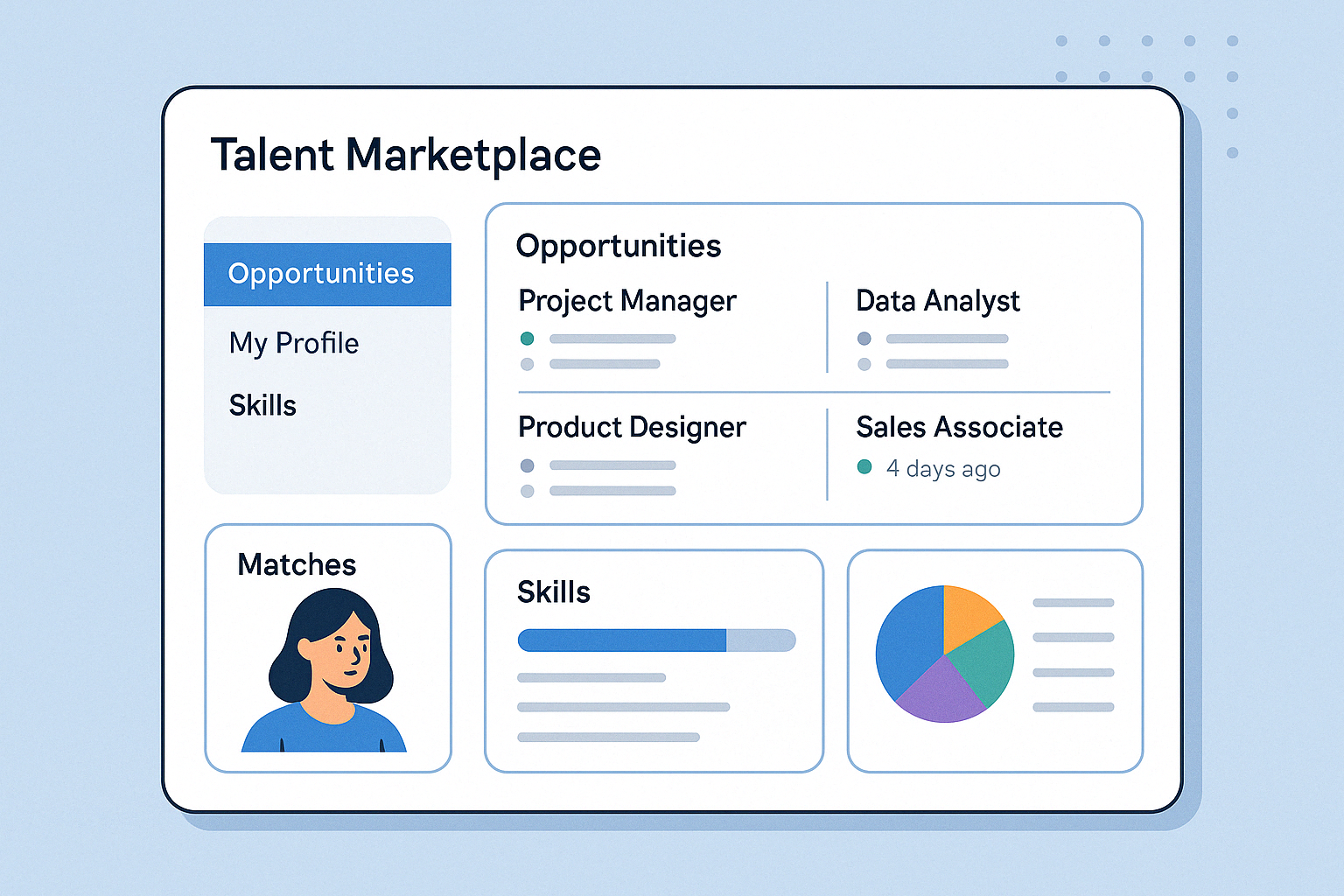Talent Marketplace: A New Era of Agile Workforce Deployment
What Is a Talent Marketplace?
A Talent Marketplace is a dynamic, AI-powered platform within an organization that matches employees with internal opportunities such as projects, full-time roles, mentorships, or stretch assignments—based on their skills, career interests, and availability.
Unlike traditional top-down workforce planning, a talent marketplace enables bottom-up mobility, empowering employees to explore growth paths while helping businesses stay agile and resource-optimized.
🔗 Related term: Skills Taxonomy
How Talent Marketplaces Work
At the core, a talent marketplace uses structured talent data—like skills, experience, preferences, and performance—often integrated with platforms like:
to match employees to opportunities within the organization in real time.
Key technologies involved:
AI & Machine Learning for skill-opportunity matching
NLP (Natural Language Processing) to parse CVs, project descriptions, learning preferences
Skills Taxonomy to structure internal capability libraries
Predictive Hiring algorithms adapted for internal mobility

Core Capabilities of a Talent Marketplace
Feature | Description |
|---|---|
Opportunity Discovery | Employees can view internal roles, gigs, learning, and mentorships tailored to their profiles |
AI Matching Engine | Recommends matches based on skills, career goals, availability, and performance trends |
Skills Gap Insights | Identifies capabilities required for target roles and suggests learning paths |
Manager Tools | Helps leaders find internal talent for agile projects or cross-functional teams |
Internal Mobility Tracking | HR teams gain visibility into talent movement, readiness, and engagement |
Benefits of a Talent Marketplace
🔄 Agility in Workforce Deployment
Respond to changing project needs or market conditions by redeploying internal talent.🎯 Talent Retention & Engagement
Employees stay longer when they see growth, learning, and movement inside the company.📈 Upskilling through Stretch Assignments
Enable hands-on learning via temporary roles or cross-team projects.💡 Visibility into Hidden Talent
Surface skills and aspirations not captured in formal roles.🤝 Democratized Access to Opportunity
Reduce bias and favoritism by ensuring open access to internal mobility.
Ideal Use Cases
Scenario | Value |
|---|---|
Digital transformation projects | Quickly staff high-impact, short-term roles |
Leadership pipeline development | Use data to match future leaders with mentorship |
DEI initiatives | Provide equal opportunity access and reduce career stagnation |
Merger & Acquisition integrations | Map talent across orgs and reassign efficiently |
Talent Marketplace vs Traditional Career Pathing
Aspect | Traditional Career Pathing | Talent Marketplace |
|---|---|---|
Mobility Type | Linear, hierarchical | Agile, non-linear |
Discovery | Manager-directed | Employee-driven |
Visibility | Limited to direct line | Cross-departmental |
Update Frequency | Annual reviews | Real-time |
Tool Support | Manual tracking | AI-powered matching |
Relationship to Other HR Technologies
A Talent Marketplace doesn’t exist in a vacuum. It thrives when integrated with:
✅ Applicant Tracking System (ATS) – for seamless internal application experiences
✅ Skills Taxonomy – to structure talent profiles
✅ AI in Performance Management – to suggest candidates based on past performance
✅ Predictive Hiring – adapted to forecast internal mobility potential
Future Trends in Talent Marketplaces
Integrated Learning Ecosystems
Automatically suggest courses or mentorships for roles an employee aspires to.AI Career Agents
Intelligent assistants that nudge employees toward roles that match their skills and ambitions.Cross-Company Talent Marketplaces
Emerging ecosystems where companies temporarily "lend" talent for cross-industry projects.Skills-as-Currency
Employees will build portable, verified skill portfolios that drive opportunities across organizations.
FAQ: Talent Marketplace
Q1: Is a Talent Marketplace the same as an internal job board?
No. While both share internal roles, a Talent Marketplace uses AI to proactively match, recommend, and guide employees—making it dynamic and personalized.
Q2: How does it impact HR strategy?
It shifts HR from top-down planning to agile, employee-centric workforce design—supporting engagement, retention, and organizational agility.
Q3: What companies use Talent Marketplaces?
Firms like Unilever, Schneider Electric, Nestlé, and Mastercard have built internal marketplaces to democratize talent mobility and foster growth.
Q4: Is a Talent Marketplace suitable for SMBs?
Yes. Even smaller organizations benefit from agile deployment and employee engagement, though tools may be simpler or integrated with their existing HCM platform.
Conclusion
A Talent Marketplace bridges employee aspirations with business needs—turning organizations into dynamic ecosystems of growth and opportunity. By harnessing AI, skills intelligence, and internal transparency, it empowers companies to thrive amid change while helping every employee find purpose and progression from within.
HR Glossary: Master the Language of Modern HR
From recruiting candidates to onboarding new team members, MokaHR gives your company everything you need to be great at hiring.
Subscribe for more information

